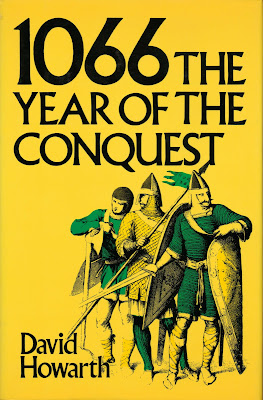Understanding the dynamics of life that surrounded our ancestors from many years ago, often involves reading books that were written to help our insights. The days of William I [1066-1087 A.D.] were certainly such a time for my Jones surname folks. Iorwerth Fychan (JI-1) the first of LLwyn-Ynn and, Gruffydd (JJ-1) the first to grow up there, generated many questions from my genealogy tree climbing exploration. The following books helped me grasp a clearer insight. The covers of my copies are shown.
From New Years Day England 1066, to New Years Eve England 1066, this text covers only the first year of the great invasion [pp.11-197]. Discussing only the first year in this time seems like a good place to start. First published by David Howarth in 1977, Dorset Press, a comment by
The New Yorker was "A model of scholarly popular history."
Without bias is generally not achieved, recognizing that it is the victor who writes the history books. But, the next book by R. Allen Brown on its cover folded inward states, "...Normandy and England, the causes, events, and results of the Conquest are examined without bias."
First edition was published 1968, and the cover shown above is taken from the second edition published 1985 by The Boydell Press, Woodbridge. My particular attention was drawn to p. 146 where the story of a Norman minstrel, by the name Taillefer, was told at the day of battle 1066. The surname is spelled various ways, Taliafo, Tolliver, Taliafro, and Talifer, but most often Taliaferro when their surname appears on my side of the great pond with my family many, many, times.
Perhaps the text with the widest range of topics is written by Robert Bartlett which includes chapters on the course of life, cultural patterns, religious life, towns and trade, and the rural foundations.
It was published 2000, by Oxford University Press. Items like the family tree of William I (p.5), yield per seed sown on Winchester estates 1211-1225 (p.305), and towns ranked by contribution to the urban aid of 1130 (p333) are presented among the 660 pages. Wow, what a resource for the dynamics of the time.
The Norman knight was generally considered the most powerful warrior of his day. The next text presents this topic with pages of colored examples taken from this period of time. Page after page the illustrations are displayed, a picture book of the day. Written by Christopher Gravett and David Nicolle and published by Osprey Publishing in 2006, writing this book, it would have been fun picking out all the images.
The chapters on the Norman stone castle are extremely helpful trying to understand what it might have been to live in one. A chronology from 911 A.D. to 1287 A.D. is outlined on pages 14-17. The principle of feudalism is discussed helping to understand this complicated topic. Just loved all the pictures.
The references for this time period would not be complete without a book about Henry II. He began his reign 1155, and was the invader into Wales when my Jones surname family made its move to LLwyn-Ynn. The politics, government of England, the Church, and the Angevin commonwealth [those from Normandy] are discussed among its 669 pages. What a deal. By W.L. Warren, it was published 1973, Butler & Tanner Ltd, London. A little heavy reading, but using the index as a guide to the subject one seeks, pp.669-693, it provides a good source of knowledge.
There you have it, my many texts of the day used often to assist my understanding of a world in Crisis.





No comments:
Post a Comment